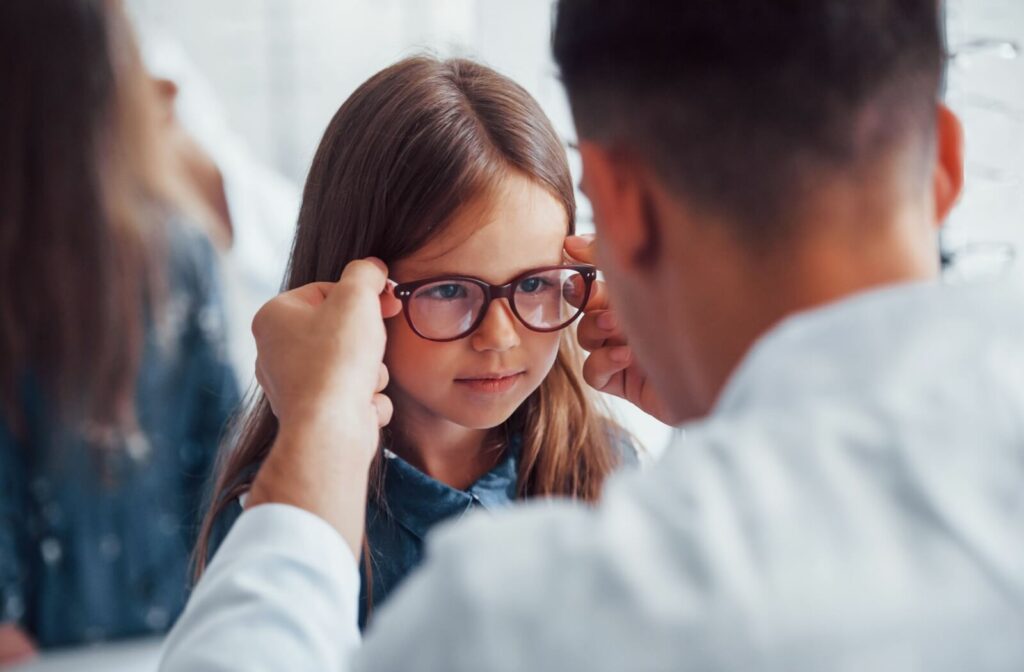Many people take clear vision for granted. However, for a parent concerned about their child’s vision or someone exploring treatment options, it’s important to understand what’s causing blurry vision.
The most commonly diagnosed vision problems are myopia (nearsightedness), which makes it easy to see close-up objects but difficult to see distant ones, and hyperopia (farsightedness), which is the exact opposite–making it easy to see far-away objects but challenging to see close-up objects.
Although these conditions may sound similar, they significantly differ in how they affect vision and how they are managed.
What Is Myopia?
Myopia, also known as nearsightedness, is a condition in which distant objects appear blurry, but close objects can be seen clearly. This happens because of elongation of the eyeball or excessive curvature of the cornea, both of which cause light rays to focus in front of the retina rather than directly on it.
Symptoms of Myopia
- Difficulty seeing objects far away, such as street signs or a classroom whiteboard
- Eyestrain, such as squinting to focus
- Headaches caused by straining to see distant objects
- Worsening vision during nighttime (night myopia)
How Common Is Myopia?
Myopia is increasingly prevalent, affecting approximately 30% of the global population. Studies suggest that excessive screen time, reduced outdoor activity, and prolonged near work (e.g., reading) may contribute to the spike in myopia cases, particularly in children.
What Is Hyperopia?
Hyperopia, commonly called farsightedness, is a vision condition in which distant objects are seen clearly, close-up objects are blurry. Unlike myopia, hyperopia occurs when the eyeball is too short, or the cornea is less curved, causing light to focus behind the retina.
Symptoms of Hyperopia
- Difficulty focusing on nearby objects, such as reading books or writing
- Blurred close-up vision, sometimes even at a moderate distance
- Eyestrain, especially after prolonged periods of near work
- Occasional headaches due to overexertion of the focusing muscles
How Common Is Hyperopia?
Hyperopia is also common, particularly among young children, as their eyes may not have fully developed. However, mild hyperopia often improves with age as the eye matures. Hyperopia impacts about 5-10% of Americans, according to the American Academy of Ophthalmology (AAO).
The Similarities Between Myopia & Hyperopia
Before we explore their differences, let’s first understand what these two conditions have in common:
- Blurred Vision: Both conditions are refractive errors, meaning that the eye’s shape prevents light from focusing correctly on the retina.
- Genetic Factors: Both myopia and hyperopia often run in families. A child’s chance of developing one of these conditions is higher if a parent or sibling has it.
- Potential Complications: If left untreated, both conditions can worsen, leading to eyestrain, headaches, or more significant issues such as amblyopia in children.
- Correctible Conditions: Both can be corrected with glasses, contact lenses, or refractive surgeries like LASIK.
What’s The Difference Between Myopia & Hyperopia?
To better understand the distinction, here’s a helpful breakdown:
| Feature | Myopia (Nearsightedness) | Hyperopia (Farsightedness) |
|---|---|---|
| Visual Clarity | Clearer close-up objects, blurry far away | Clearer far away objects, blurry close-up |
| Eye Shape | Elongated | Shortened |
| Light Focus | Falls in front of the retina | Falls behind the retina |
| Age of Onset | Usually in childhood | Can be present in childhood or later |
| Common Symptoms | Squinting, eyestrain, blurred distance | Eyestrain, blurred close vision, headaches |
While both conditions involve a refractive error, their effects on vision and required corrections are fundamentally opposite.
How Do Myopia & Hyperopia Affect Children?
It’s important to consider how these conditions impact children, as early detection can play a significant role in visual development and academic performance.
Myopia in Children
Myopia often begins in school-aged children and may progressively worsen during teenage years. If left untreated, it can hinder their ability to see the classroom board or participate in sports. Early intervention, including regular eye exams, is critical for monitoring the progression of myopia.
Hyperopia in Children
Many children naturally have mild hyperopia, which may not cause problems as their eyes can compensate by focusing. However, severe hyperopia can lead to difficulty reading, delayed development of hand-eye coordination, and issues like strabismus (crossed eyes) or amblyopia (lazy eye).
How Do Doctors Treat Nearsighted & Farsighted Patients?
If you suspect myopia or hyperopia, it’s important to seek professional care. Ignoring these conditions can lead to chronic eye strain and a reduced quality of life.
Thankfully, various options exist for managing and treating these conditions, which offer customized solutions based on individual needs and goals.

1. Glasses
Glasses are the most common solution for both myopia and hyperopia. They’re noninvasive and reliable ways to correct refractive errors. For myopia, glasses with concave lenses are used, while for hyperopia, convex lenses are prescribed.
2. Contact Lenses
Contact lenses are an excellent option for those seeking an alternative to glasses, offering a wider visual field and greater convenience, especially for active individuals.
3. Orthokeratology (Ortho-K)
This treatment involves wearing specially designed contact lenses overnight to reshape the cornea temporarily. Ortho-K is primarily used for myopia control in children.
4. Refractive Surgery
Advanced techniques like LASIK or PRK (Photorefractive Keratectomy) are available to adults seeking a more permanent vision solution. These surgeries reshape the cornea, correcting both myopia and hyperopia.
5. Lifestyle Adjustments
Reducing screen time, ensuring proper lighting while reading, and getting regular outdoor activity can help slow myopia progression and minimize the strain of hyperopia.
6. Regular Eye Exams
Routine eye exams are the backbone of good eye health. Optometrists can track vision changes and adjust your prescription, ensuring optimal eye care.
See Beyond the Blurry Lines
Understanding the differences between myopia and hyperopia is a significant step toward better eye health for you and your family. Addressing vision needs early is key to living without limits, whether ensuring your child thrives at school, or you can efficiently perform tasks.
At Bluebird Vision & Wellness, we’re committed to helping every patient achieve clearer, healthier vision. If you or a loved one are experiencing blurry vision or struggling to focus, contact us today to schedule a comprehensive eye exam with us.




